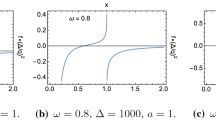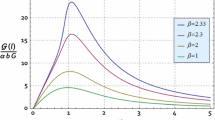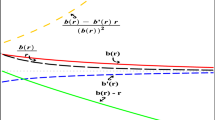Abstract
The electrostatic potential generated by a point charge at rest in a simple static, spherically symmetric wormhole is given in the form of series of multipoles and in closed form. The general potential which is physically acceptable depends on a constant due to the fact that the monopole solution is arbitrary. When the wormhole has \(Z_2\)-symmetry, the potential is completely determined. The calculation of the electrostatic self-energy and of the self-force is performed in all cases considered.
Similar content being viewed by others
References
Khusnutdinov, N.R., Bakhmatov, I.V.: Phys. Rev. D 76, 124015 (2007)
Khusnutdinov, N.R., Bakhmatov, I.V.: Grav. Cosm. 14, 100 (2008)
Krasnikov, S.: Class. Quantum Gravity 25, 245018 (2008)
Khusnutdinov, N.R., Popov, A.A., Lipatova, L.N.: Class. Quantum Gravity 27, 215012 (2010)
Beskin, V.S., Kardashev, N.S., Novikov, I.D., Shatskii, A.A.: Astron. Rep. 55, 753 (2011)
Bezerra, V.B., Khusnutdinov, N.R.: Phys. Rev. D 79, 064012 (2009)
Popov, A.A.: Phys. Lett. B 693, 180 (2010)
Morris, M.S., Thorne, K.S.: Am. J. Phys. 56, 395 (1988)
Ellis, H.G.: J. Math. Phys. 14, 104 (1973)
Bronikov, K.A.: Acta Phys. Polon. B 4, 251 (1973)
Visser, M.: Lorentzian Wormholes: From Einstein to Hawking. AIP Press, New York (1996)
Linet, B.: arXiv:0712.0539 (2007)
Olver, F.W.: Introduction to Asymptotics and Special Functions. Academic Press, New York (1974)
Linet, B.: J. Phys. A 9, 1081 (1976)
Damour, T., Solodukhin, S.N.: Phys. Rev. D 76, 024016 (2007)
Casals, M., Poisson, E., Vega, I.: Phys. Rev. D 86, 064033 (2012)
Linet, B.: Gen. Relativ. Gravit. 37, 2145 (2005)
Author information
Authors and Affiliations
Corresponding author
Appendices
Appendix A: The Green function of the radial differential equations
Let the self-adjoint differential equation with a source term
and the corresponding homogeneous equation
where the functions \(p,\,dp/dx\) and \(q\) are continuous and moreover \(p\) is strictly positive on \((-\infty , \infty )\).
In the context of our present work, we assume that the homogeneous equation (61), admits two regular solutions \(A^{(i)}\) and \(A^{(e)}\), linearly independent, having respectively the following boundary conditions:
The solutions \(A^{(i)}\) and \(A^{(e)}\) are fixed up to a multiplicative constant. The nonvanishing Wronskian \(\mathcal{W}(A^{(i)},A^{(e)})\) can be easily expressed in the form
where \(k\) is a constant.
The Green function \(A(x,a)\) of the differential equation (60), which verifies the boundary conditions
is defined by the other following properties:
-
a.
\(A(x,a)\) satisfies the homogeneous equation (61) except at \(x=a\).
-
b.
\(A(x,a)\) is continuous at \(x=a\).
-
c.
The derivative of \(A(x,a)\) with respect to \(x\) has a jump discontinuity of magnitude \(c/p(a)\) at \(x=a\).
These conditions ensure that \(A(x,a)\) satisfies the differential equation (60) in the sense of distributions with the boundary conditions (64).
It is now possible to determine this Green function \(A(x,a)\) with the help of the functions \(A^{(i)}\) and \(A^{(e)}\). Consider the function \(H\) defined by
It is obvious that \(H(x,a)\) verifies all the properties of a Green function. For simplicity, it is possible to take \(k=c\) by a judicious choice of functions \(A^{(i)}\) and \(A^{(e)}\) defined up to a multiplicative constant. Thus, the Green function of the differential equation (60) has expression (65) with \(k=c\) that one can rewrite in the form
where \(\theta \) is the Heaviside step function.
Appendix B: Explicit electrostatic potential in higher dimensions
Metric (1) can be easily generalised to describe the spacetime representing a wormhole in \(n+1\) dimensions, \(n\ge 3\). We take
with \(-\infty <l<\infty \), and where \(d\Omega _{n-1}^{2}\) is the metric of the sphere \(S^{n-1}\) described in the coordinates \((\vartheta _1,\dots ,\vartheta _{n-2},\varphi )\). The change of radial coordinates (33) expresses metric (67) in isotropic coordinates
with \(r>0\). We set the associated Cartesian coordinates \((x^i),\,i=1,\dots ,n\). Metric (68) can be written thereby
where \(r=\sqrt{( x^1)^2+\cdots +( x^n)^2}\).
We consider the usual Maxwell equations in a spacetime of \(n+1\) dimensions. The charge density \(\rho \) for a point charge \(e\) located at \(x^i=x_{0}^{i}\) has the expression
where \(g\) is the determinant of metric (69) given by
The electrostatic equation in metric (69) takes the form
where \(\triangle \) is the usual Laplacian operator, and in which the function \(h\) has the expression
In a previous work [17] , it was shown that exact solutions to the electrostatic equation (72) exist in the form
with
if the function \(h\) satisfies a certain differential equation. It may be only the type II with \(a=w/2\) in the classification of this work. Consequently, the function \(h\) must satisfy the differential equation
in which the two constants \(b\) et \(A\) are to be fixed.
From (73), we calculate
By comparing (76) and (77), we find the value of the constants: \(b=w/2\) and \(A=-4n+8\).
We are thus in the case where the electrostatic equation (72) has solutions in the form (74). According to the results of the work [17], the functions \(k\) and \(g\) are expressed as
and the function \(F\) is determined by the differential equation
As variable \(s\) we have set
The value \(s=0\) corresponds to the position of the point charge. We emphasize that
This comes from that fact that we can always take the particular case where the point charge is located at \(\vartheta _1=0\) without lost of generality, due to the spherical symmetry. Inequality (81) is then written
which is equivalent to the recognized inequality
We firstly find a particular solution to (79)
A classical method shows that the general solution to (79) is given by
where \(f_1\) and \(f_2\) are two arbitrary constants. The integral in (83) can be explicitly performed for all values of \(n\).
We will choose the constants \(f_1\) and \(f_2\) first of all so that solution (74) is regular everywhere, except at \(x=x_0\). This occurs if the function \(F\), given by (83), has only a singularity at \(s=0\). Now we have
therefore we take the relation
The important point is that solution (74) satisfies the electrostatic equation (72) in the sense of distributions. By noticing from (83) that
we can deduce the most divergent part of \(V\) as \(x\rightarrow x_0\)
By considering the source term of Eq. (72), we take
since
So ,we obtain
Now with (78), (80) and (87), we are in position to write from (74) the potential \(V(x)\) generated by a point charge at \(x=x_0\).
Rights and permissions
About this article
Cite this article
Boisseau, B., Linet, B. Electrostatics in a simple wormhole revisited. Gen Relativ Gravit 45, 845–864 (2013). https://doi.org/10.1007/s10714-013-1504-2
Received:
Accepted:
Published:
Issue Date:
DOI: https://doi.org/10.1007/s10714-013-1504-2




